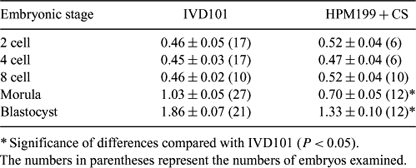129 RESPIRATION ACTIVITY OF BOVINE EMBRYOS CULTURED IN SERUM-FREE AND SERUM-CONTAINING MEDIA
H. Abe A , H. Shiku B , S. Aoyagi C , T. Matsue B and H. Hoshi DA Tohoku University Biomedical Engineering Research Organization, Sendai, Japan
B Graduate School of Environmental Studies, Tohoku University, Sendai, Japan
C Hokuto Denko Corporation, Tokyo, Japan
D Research Institute for the Functional Peptides, Shimojo, Yamagata, Japan. Email: abe@tubero.tohoku.ac.jp
Reproduction, Fertility and Development 17(2) 215-215 https://doi.org/10.1071/RDv17n2Ab129
Submitted: 1 August 2004 Accepted: 1 October 2004 Published: 1 January 2005
Abstract
Oxygen consumption is a ubiquitous parameter which can provide valuable information about metabolic mechanisms and embryo quality. Recently, we succeeded in non-invasively and quantitatively determining oxygen consumption of individual bovine embryos by the scanning electrochemical microscopy (SECM). The aim of this study was to assess by SECM the oxygen consumption of individual bovine embryos at different developmental stages cultured in serum-free and serum-supplemented media. Bovine oocytes were matured in IVMD101 medium [Research Institute for the Functional Peptides (IFP), Shimojo, Yamagata, Japan] and inseminated in BO-based medium. For serum-free culture, inseminated ooocytes were cultured to the blastocyst stage in IVD101 medium in an atmosphere of a low oxygen condition (5% CO2/5% O2/90% N2) at 38.5°C. For serum-supplemented culture, inseminated oocytes were cultured in HPM199 medium (IFP) supplemented with 5% calf serum (HPM199 + CS) in the presence of bovine cumulus/granulosa cells in a humidified atmosphere of 5% CO2 in air. Oxygen consumption by individual bovine embryos was non-invasively quantified by the SECM measuring system. Some embryos were prepared for transmission electron microscopy. The oxygen consumption rates are presented in the table. Oxygen consumption rates (F) of the single embryos were low from 2-cell to 8-cell stages (0.45–0.52 × 10−14 mol s−1). In serum-free culture, an increase in oxygen consumption rate was found at the morula (1.03 × 10−14 mol s−1) stage, and blastocysts showed an even higher oxygen consumption rate (1.86 × 10−14 mol s−1). On the other hand, the oxygen consumption of morulae and blastocysts produced in serum-supplemented medium was lower than that of embryos cultured in serum-free medium. Electron microscopic study demonstrated that many of the mitochondria of morulae and blastocycts cultured in HPM199 + CS medium were an immature form, indicating a correlation between respiration activity and development of mitochondria. These results suggest that the culture conditions affect the respiration activity of bovine embryos. The SECM procedures may have a wide application for judging embryo quality and culture conditions for embryos.

|


